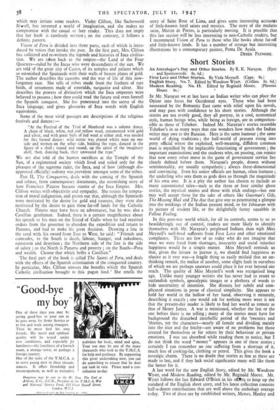Incas and Saints
ADMIRERS of Violet Clifton's The Book of Talbot will not be dis- appointed in her new work. Vision of Peru is exciting, pi-ovocative and beautifully written, and is almost as strange as the legendary Peru that it describes. Readers in search of knowledge about the fabulous land of the Incas, of the Spanish conquerors like Pizarro, and of that far-off Spanish Empire that followed the conquest of Peru will fmd it fascinating. The publishers tell us that Mrs. Clifton has lived for years in Peru, Bolivia and Ecuador, and there is no doubt that her knowledge of the customs, legends and history of these countries is profound. Indeed, Vision of Peru exhibits an almost overpowering erudition, and it is written in a personal style
which may irritate some readers. Violet Clifton, like- Sacheverell Siwell, has invented a world of imagination, and she makes no compromise with the casual or lazy, reader.. This does not imply that her book is carelessly written ; on the contrary, it follows a. definite pattern.
Vision of Peru is divided into three parts, each of which is intro- duced by voices that invoke the past.. In the first part, Mrs. Clifton
has collected and re-written the legend's and histories of Inca civilisa-
tion. We are taken back to the empire—the Land of the Four Quarters—ruled by the Incas who were descendants-of the sun. We
are told of the great city of Cuzco, of its temples and palaces which so astonished the Spaniards with their walls of beaten plates of gold. The author describes the customs and the way of life of this now- forgotten race. She tells of robes made from the feathers of rare birds, of ornaments made of emeralds, turquoise and silver. She describes the powers of divination which the Inca emperors were believed to possess ; how they could read the future and even foretell the Spanish conquest. She has penetrated into the secret of the Inca language, and gives glossaries of Inca words with English equivalents.
Some of the most vivid passages are descriptions of the religious festivals and dances .:—
"At the Festival of the Trial of Manhood was a solemn dance. A chain of black, white, red and yellow wool, ornamented with gold and silver, and with great balls of red wool at either end, was needed for this eormal dance : wild music was played whilst men on one side and women on the other side, holding the rope, danced in the figure of a shell ; round and round, up the spiral of the imaginary shell, then, dancing back, they unwound the rope."
We are also told of the human sacrifices at the Temple of the Sun, of a regimented society which lived and toiled only for the pleasure of the supreme ruler, the Inca, and of how (although dis-
approved officially) sodomy was prevalent amongst some of the tribes. Part II, The Conquerors, deals with the coming of the Spanish and relates, from contemporary documents, the astonishing story of
how Francisco Pizarro became masfer of the Inca Empire. Mrs.
Clifton writes with objectivity and sympathy. She resists the tempta- tion of moral indignation, and points out that, although the Spaniards were motivated by the desire for gold and treasure, they were also
motivated by,. the desire to gain these far-off lands for the. Catholic Church. Pizarro may have been an adventurer, but he was also a
Castilian gentleman. Indeed, there is a certain magnificence about his speech to his men on the Island of Gallo when he had received orders from the governor to abandon the expedition and 'return to Panama, and had to make his great decision. Drawing a line in the sand with his sword from East to West, he said: " Friends and comrades, to the South is °death, labour, hunger, and nakedness, rainstorm and desertion ; the Northern side of the line is the side of safety ; to the North is Panama and poverty ; on the South—Peru and wealth. Choose that which befits a Castilian."
The final part of the book is called The Saints of Peru, and deals with the effects of the Spanish colonisation of the conquered country. In particular, Mrs. Clifton stresses the benefits which the Spanish Catholic civilisation brought to this pagan land. - She retells the story of Saint Rose of Lima, and gives some interesting accounts of little-known local saints and mystics. The story of the mulatto saint, Martin de Porres, is particularly moving. It is possible that this last section will be less interesting to non-Catholic readers, but I recommend Vision of Peru to those who like books about far-off and little-known lands. It has a number of strange but interesting illustrations by a contemporary painter, Poma De Ayala. -
DEREK PATMORE.



































 Previous page
Previous page